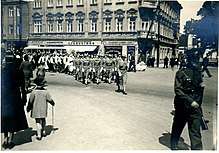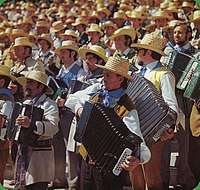Lithuanian Song Festival

The Lithuania Song Festival (also called Song Celebration) is a massive traditional song and dance festival.[1] Since regaining the Independence in 1990, the event takes place every four years. The most recent event took place from July 2–6, 2014 in Vilnius.[2] The 2018 edition of the Song Celebration is dedicated to the Centenary of the Restoration of the independent state of Lithuania and will take place in Kaunas and Vilnius between 30 June and 6 July.[3] In recent years the main event has been hosted in Vingis Park in Vilnius.
On 7 November 2003, UNESCO has proclaimed the tradition of the Song and Dance Celebration in Lithuania, Latvia and Estonia as a Masterpiece of the Oral and Intangible Heritage of Humanity and in 2008 it has been inscribed in the UNESCO Representative List of the Intangible Cultural Heritage of Humanity.[4]
History





Song Festival in the Little Lithuania
The Rambynas Hill, located in the Small Lithuania region, has become a favorite place for singing and for gathering. The 17 February 1895 is recorded in the history as the debut of the first Lithuanian choir. The concert was held to celebrate the 10th anniversary of the Lithuanian community "Birutė".
On 2 December 1895 the Tilsit Lithuanian Singers’ Community was founded led by Vydūnas (Vilius Storosta). The community used to organise theatre performances, concerts, evenings, St. John’s Day festivities in Tilsit, Klaipėda, Gumbinė, Verdainė, Rusnė, Ragainė, Juodkrantė, Smalininkai. Up to one thousand spectators used to gather at the events, so called the winter and summer Lithuanian celebrations, later in 1902 entitled the Song Celebrations.
On June 6, 1927, the first Lithuanian Song Festival of Klaipėda Region took place. 12 choruses with 800 singers and 100 orchestra took part in the event. The joint choir was conducted by Antanas Vaičiūnas and Vydūnas. On 1928, the Second Song Festival of Klaipėda was organized in Šilutė.
Interwar Lithuania
The first song festival in Lithuania was held in 23-25 August 1924 in Petras Vileišis Square, Kaunas, during the Agricultural and Industrial Exhibition. The festival's initiator was Juozas Žilevičius, with chief conductors Juozas Naujalis, Stasys Šimkus and Julius Štarka. The choirs conductor was Kostas Gurevičius, Mykolas Karka, Apolinaras Likerauskas, Vladas Paulauskas and Antanas Vaičiūnas. There are 77 choirs participated with 3000 singers and 50 thousand spectators.
Since then, the song festival became a tradition in Lithuania. The Second Lithuanian Song Festival was dedicated to the 10th anniversary of Lithuania's Independence took place in 1-2 July 1928 in Kaunas. There were 51 church choirs, 22 choirs of gymnasia and other schools, 19 choirs of various associations and organizations, and choir of the Riga Lithuanian "Lights" (headed by Juozas Karosas), with 6000 singers. The joint choir was conducted by Stasys Šimkus and Juozas Gruodis. During the celebration 250 gymnastics exercises took place at the school square. They were accompanied by a choir that was singing popular folk songs. The Second Song Festival was listened by about 100 thousand spectators.
The third song festival was held in 20 June 1930 to celebrate the 500th anniversary of Vytautas the Great's death. About 200 choirs and 9,000 singers participated in the event. The event performed 24 works - one psalm, six original works and harmonized folk songs. The chief conductors was Juozas Naujalis, Nikodemas Martinonis, and Juozas Gruodis.
The first dance festival is held on 29 October 1937. A celebration was organized in Kaunas for Young Lithuanians , in which 448 dancers from different regions of Lithuania danced a few national dances.
In 1920 until 1944, a number of regional, city and other local song festivals were held. They were organized by public organizations. Since 1930 some organized regional song and sport festivals were held for schoolchildren.
During the Soviet occupation
The tradition of song festivals was continued during the Soviet occupation. In 1946, 188 choirs with 11,778 singers participated in the song festival, and sung songs composed by 15 composers and 15 Lithuanian harmonized songs. The chief Conductors for the 1946 edition were Nikodemas Martinonis, Jonas Švedas, Konradas Kaveckas and Antanas Ilčiukas.
From 1950, Dance Day was added to the Song Festival. The festival was attended by 57 dance groups, 41 ensemble ensemble and 13 wind instrumental orchestras.
Since 1950, song and dance festival events were organized periodically every 5 years. The tradition of song and dance festivals, like other arts, had the dogma of Soviet aesthetics and politics, and Lithuanian art was supposed to be a form of nationalism, but with socialist content.
According to an Estonian architect's project, the Vingis Park Amphitheater was opened in time for the 1960 edition of the festival.
From the song and dance festival tradition, the Student Song Festival has grown, and has been periodically featured as an independent event since 1964.
The Song Festival in the Lithuanian diasporas
Lithuanian diasporas also held the song festivals. The first Lithuanian diaspora song festival was organized in Würzburg, Germany, on 1956. The festivals was also held by Lithuanians living abroad (especially on the US and Canada), and was held every five years.
Current Lithuania
After the restoration of Lithuania's independence, in 1990, The 13th Lithuanian Song Festival was held, and the festival was since a national tradition. Since 1990, the event is organized every four years at the beginning of July.
An average of 30 thousand participants take part in the festivals. A total of 17 song festivals were organized until today.
Components
The festival is organized into 12 main programs. These programs have to do with Lithuanian workshops, costumes, theatre, dance, and processions.[5] The song festival's primary parts are Folklore Day, unfolding the geographical and genre diversity of traditional culture, and the Ensembles Night.[6]
See also
References
- ↑ Lithuania's song festival - education in Soviet-era living conditions - EN.DELFI
- ↑ President opens Lithuanian song festival
- ↑
- ↑ History of the Lithuanian Song Festival
- ↑ Song Festival invites 37,000 performers and 150,000 spectators to celebrate Lithuanian identity | Culture | Live | iVilnius.com - Vilnius city guide
- ↑ THE MILLENNIUM SONG FESTIVAL OF LITHUANIA | News | Ministry of Foreign Affairs
External links
| Wikimedia Commons has media related to Lithuanian Song Festival. |